Atención: Este post forma parte de la iniciativa de la Comunidad Humanitas, Reflexiones en Comunidad, puedes ver el post original aquí
Cuerpos Humanos: Lo Determinado y la Comprensión de la Corporalidad
Es sin dudas el cuerpo humano y su percepción y sobre todo su autopercepción tema de debate constante en varias áreas de la vida. A lo largo de nuestro desarrollo buscamos cómo explorar de una forma u otra nuestros cuerpos. El ser humano, en su afán de búsqueda de respuestas constantes, ha encontrado una forma única de explorar el cuerpo: el arte.

Mucho antes del surgimiento del término arte tal y como lo conocemos hoy, la observación y representación de cuerpos ha sido una necesidad, con una visión muy temprana de esto en la Venus de Willendorf, una figura que data del paleolítico y representaba a la mujer como símbolo de abundancia y fertilidad. A medida que las civilizaciones fueron tomando el mundo como suyo el arte mutó y con ellos las representaciones de los cuerpos, en un vaivén entre realismo absoluto, abstracción e idealización, lo que sí se ha mantenido es la invitación a reflexionar a través de estas representaciones sobre nuestra propia existencia y humanidad, buscando un significado más profundo a la mera existencia.
| Venus de Willendorf |
|---|
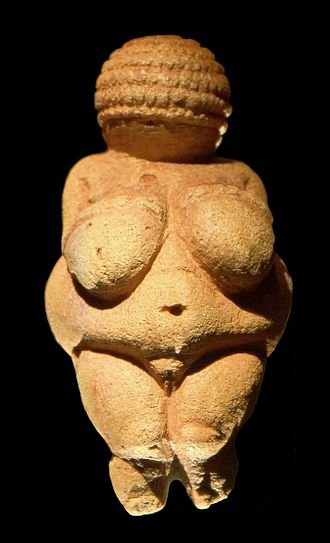 |
| Source |
Para analizar el cuerpo humano y el arte me gustaría dividirlo en cuatro puntos o aspectos fundamentales a tener en cuenta: existencia material, identidad cultural, limitaciones físicas, cambios constantes y conexión mente-cuerpo.
Existencia Material:
Es asombroso cómo un conglomerado de células, algunos huesos y músculos defectuosos pueden crear una máquina tan compleja como nuestro cuerpo, y aunque la visión de absoluta perfección de nuestra parte material es extremadamente contradictoria, el arte ha hecho lo mejor que ha podido en busca de apreciación y fidelidad: el David de Miguel Ángel, los estudios anatómicos en las libretas de bocetos de Leonardo da Vinci exploran más allá de cómo funciona el cuerpo humano, es un homenaje a la complejidad del cuerpo como materia misma y su interacción con el medio. Pero ¿puede el arte captar la esencia metafísica de un cuerpo que es solo materia? o ¿va el arte más allá de una representación, una imitación a la materia, a lo observable y diseccionable?
| David de Miguel Ángel | Bocetos de Leonardo da Vinci |
|---|---|
| https://upload.wikimedia.org/wikipedia/commons/thumb/8/80/Michelangelo%27s_David_-right_view_2.jpg/500px-Michelangelo%27s_David-_right_view_2.jpg |  |
| Source | Source |
Identidad Cultural
Los cuerpos son brújulas que nos guían a nuestro origen, son piezas del rompecabezas de la humanidad, cada pieza se puede parecer pero es irrepetible. En el moldeo de estas piezas están las construcciones sociales y culturales, aquello que nos hace diferenciar y que así de contradictorio es de necesario. Muchos pueblos llegan incluso a la modelación corporal o agregan adornos en forma de tatuajes, piercings y pendientes como forma de autoexpresarse. Tenemos una necesidad inherente de contar historias colectivas e individuales a través de nuestro cuerpo y esto ha estado representado en el arte. A mi lado del mundo tenemos a Frida Kahlo, que a pesar de no ser uno de mis más grandes referentes, su obra Las Dos Fridas es un ejemplo de narración a través del cuerpo, una historia de identidad o búsqueda de identidad a través de vivencias culturales colectivas e individuales. El arte desafía sin dudas las percepciones construidas por nuestra cultura, pero también como la dualidad de Las Dos Fridas, las refuerza.
| Las Dos Fridas de Frida Kahlo |
|---|
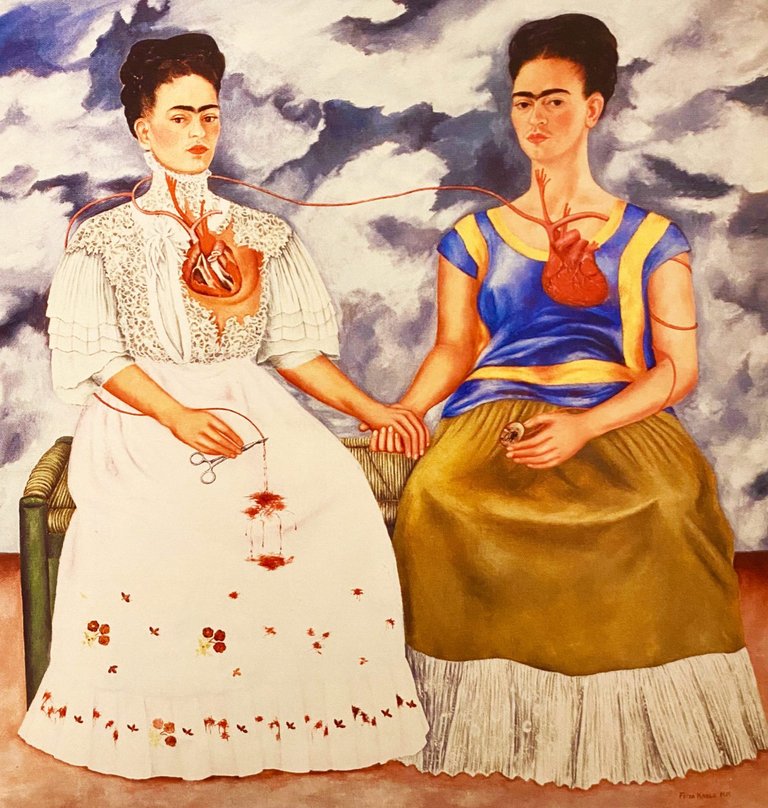 |
| Source |
Limitaciones Físicas
Cuando hablo de las limitaciones físicas no puedo dejar de pensar en los performances de Marina Abramović, y su desafío al propio cuerpo, a la vez una ola de dudas sobre qué es arte me asaltan, pero no es el tema de hoy. Abramović como Chris Burden jugaron a llevar al límite el cuerpo humano, y lo que era capaz, pero mucho antes Cézanne había desafiado los límites de otra forma distorsionando miembros y perspectivas para acentuar las emociones y con esa desconfiguración y rotura del límite del cuerpo humano dejaba a un lado las normas y le abría paso a lo que más tarde sería el cubismo. ¿Es entonces, la representación idealizada la forma más precisa de captar lo que en realidad somos?
| Marina Abramović y Ulay, libro de artista, museo CODA, 1978 | El asesinato de Paul Cézanne, h. 1870. |
|---|---|
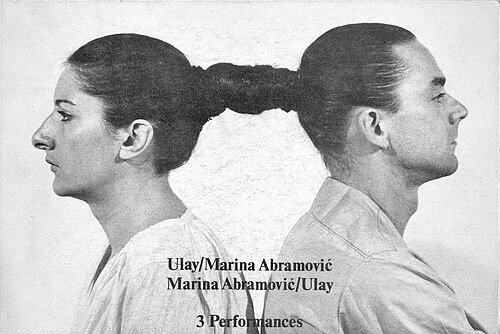 |  |
| Source | Source |
Cambios Constantes
El cuerpo humano se está transformando constantemente y quizás es de los conceptos más temidos por muchos, está en nuestra naturaleza, escrito en nuestro ADN temer al cambio. Nuestra naturaleza efímera y ese temor a dejar de existir es de los temas más comunes en el arte, pero antes de hablar de cualquier obra en específico pensemos en la Diosa Triple de algunas tradiciones neopaganas, la diosa mostraba sus tres caras asociadas a tres fases de la luna, niña, mujer y anciana, esto nos da una idea de lo importante y simbólico que han sido los cambios en los cuerpos a través del tiempo, estos cambios están reflejados en obras como Las Tres Edades y la Muerte de Hans Baldung o más cercano Las Tres Edades de la Mujer de Klimt con su enfoque a lo cíclico de la vida misma. Es imposible que no surja esta pregunta en mi mente: ¿es el arte la forma que tenemos de trascender más allá de estos cambios, de inmortalizar un fragmento del tiempo o tratar de comprenderlo de la forma más amplia posible? ¿Qué revela el arte sobre lo que significa para nosotros el tiempo?
| Diosa Triple | Las Tres Edades y la Muerte de Hans Baldung | Las Tres Edades de la Mujer de Klimt |
|---|---|---|
 |  | 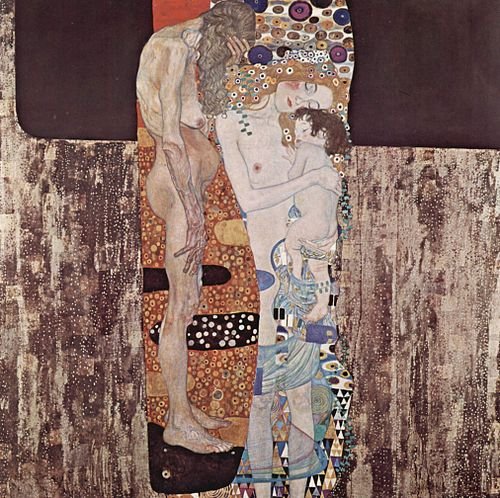 |
| Source | Source | Source |
Conexión (Interconexión) Mente-Cuerpo
Quizás y regresando a los puntos anteriores, la forma más común y casi superior en la que nuestros cuerpos se conectan con el arte es siendo este último una extensión física de la mente, una forma de plasmar en lo material nuestros miedos y anhelos más viscerales, una conexión que fluye entre emociones, pensamientos y nuestro propio cuerpo físico. ¿Acaso las deformaciones en el rostro de la figura central de El Grito de Edvard Munch no son en sí mismas una deformación de la mente, una muestra física del propio temor y opresión que azota en la escena? ¿O acaso el polémico Salvador Dalí no creó una realidad propia donde cuerpos y estados mentales se entrelazan? ¿O la deshumanización y transfiguración de los cuerpos de Guernica de Pablo Picasso no nos muestran la propia pérdida de la humanidad tras la guerra? Desde el dualismo cartesiano la pregunta que debemos hacernos es: ¿Puede el arte representar la mente como una extensión del cuerpo o es el arte otra de las dimensiones de nuestro cuerpo?
| El Grito de Edvard Munch | Galatea de las esferas, Salvador Dalí | Guernica de Pablo Picasso |
|---|---|---|
| https://upload.wikimedia.org/wikipedia/commons/thumb/9/9d/The_Scream_by_Edvard_Munch%2C_1893_-Nasjonalgalleriet.png/375px-The_Scream_by_Edvard_Munch%2C_1893-_Nasjonalgalleriet.png | https://historia-arte.com/_/eyJ0eXAiOiJKV1QiLCJhbGciOiJIUzI1NiJ9.eyJpbSI6WyJcL2FydHdvcmtcL2ltYWdlRmlsZVwvNWYxYzA0NzlmMThhNS5qcGciLCJyZXNpemUsMTUwMHxmb3JtYXQsd2VicCJdfQ.uXy3oOUnHY2rR8wncbGQRFdugbieubasw15h3fu-QTc.webp | 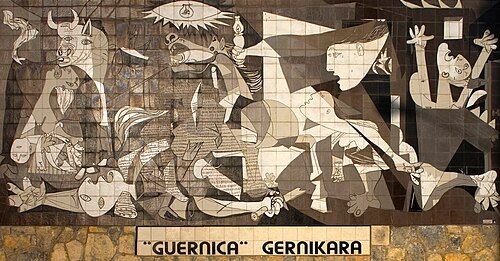 |
| Source | Source | Source |
A lo largo de estas palabras he querido poner sobre la mesa conceptos y temas que son diversos, complejos y hasta cierto punto polarizados, por lo tanto quiero que sea tomado más como una reflexión o introspección personal, no un artículo con total rigidez investigativa o académica, solo soy un aprendiz de todo y maestro de nada, así que pido perdón por cualquier error, argumento errado o gazapo en general. Mis más sinceras disculpas.
Como siempre es y será un placer abrir el debate en los comentarios. Mis saludos y deseos de suerte y éxitos.
Quiero agradecerles sinceramente por tomarse el tiempo de leer este artículo. Su apoyo significa mucho para mí y me motiva a seguir compartiendo contenido que pueda ser útil e interesante para ustedes. Si encontraron este artículo útil o disfrutaron leyéndolo, les agradecería enormemente sus comentarios. Éxitos.

Attention: This post is part of the Humanitas Community initiative, Reflections in Community. You can view the original post here.
Human Bodies: The Determined and the Understanding of Corporality
Undoubtedly, the human body and its perception, especially self-perception, are constant topics of debate in various areas of life. Throughout our development, we seek ways to explore our bodies in one way or another. Humans, in their relentless search for answers, have found a unique way to explore the body: through art.

Long before the emergence of the term "art" as we know it today, the observation and representation of bodies was a necessity, with an early vision of this found in the Venus of Willendorf, a figure dating back to the Paleolithic era that represented women as symbols of abundance and fertility. As civilizations claimed the world as theirs, art evolved along with them, and so did the representations of bodies, swinging between absolute realism, abstraction, and idealization. However, what has remained constant is the invitation to reflect on these representations about our own existence and humanity, seeking a deeper meaning beyond mere existence.
| Venus of Willendorf |
|---|
 |
| Source |
To analyze the human body and art, I would like to divide it into four fundamental aspects to consider: material existence, cultural identity, physical limitations, constant changes, and mind-body connection.
Material Existence:
It's astonishing how a conglomerate of cells, some bones, and imperfect muscles can create such a complex machine as our body. Although the vision of absolute perfection in our material existence is highly contradictory, art has done its best to pursue appreciation and fidelity. The David of Michelangelo and anatomical studies in Leonardo da Vinci's sketchbooks delve deeper than how the human body functions, serving as a tribute to the complexity of the body as material itself and its interaction with the environment. But can art capture the metaphysical essence of a body that is merely material? Or does art go beyond representation, imitating matter, the observable, and the dissectible?
| Michelangelo's David | Leonardo da Vinci's Sketches |
|---|---|
| https://upload.wikimedia.org/wikipedia/commons/thumb/8/80/Michelangelo%27s_David_-right_view_2.jpg/500px-Michelangelo%27s_David-_right_view_2.jpg |  |
| Source | Source |
Cultural Identity
Bodies are compasses guiding us to our origins; they are pieces of humanity's puzzle, each resembling others yet irreproducible. In shaping these pieces, social and cultural constructs emerge—what differentiates us and, paradoxically, becomes essential. Many peoples even resort to body modifications or add adornments such as tattoos, piercings, and earrings as forms of self-expression. We have an inherent need to tell collective and individual stories through our bodies, represented in art. On my side of the world, Frida Kahlo, though not one of my greatest inspirations, exemplifies this with her work The Two Fridas, a narrative through the body, a story of identity or search for identity through collective and individual cultural experiences. Undoubtedly, art challenges perceptions constructed by our culture, but like the duality in The Two Fridas, it also reinforces them.
| The Two Fridas by Frida Kahlo |
|---|
 |
| Source |
Physical Limitations
When discussing physical limitations, Marina Abramović and her challenge to the body come to mind. At the same time, a wave of doubts about what is art strikes me, but that’s a topic for another day. Abramović, like Chris Burden, pushed the limits of the human body and its capabilities, yet much earlier, Cézanne challenged limits in another way, distorting limbs and perspectives to accentuate emotions. With this disconfiguration and breaking of human body limits, Cézanne bypassed norms, paving the way for cubism. So, is idealized representation the most accurate way to capture what we truly are?
| Marina Abramović and Ulay, artist book, CODA museum, 1978 | The Murder by Paul Cézanne, circa 1870 |
|---|---|
 |  |
| Source | Source |
Constant Changes
The human body is constantly transforming and perhaps is one of the most feared concepts for many; it’s in our nature, written in our DNA, to fear change. Our ephemeral nature and that fear of ceasing to exist are among the most common themes in art. But before discussing specific works, let’s consider the Triple Goddess from some Neopagan traditions. The goddess reveals three faces associated with the moon's phases—maiden, woman, and crone. This symbolism gives an idea of how important and symbolic changes in bodies through time have been. Such transformations are reflected in works like The Ages and Death by Hans Baldung or closer to us, The Three Ages of Woman by Klimt with its focus on the cyclical nature of life itself. Inevitably, this question arises: is art our way to transcend beyond these changes, immortalizing a fragment of time or trying to understand it in the broadest possible way? What does art reveal about what time means to us?
| Triple Goddess | The Ages and Death by Hans Baldung | The Three Ages of Woman by Klimt |
|---|---|---|
 |  |  |
| Source | Source | Source |
Mind-Body Connection (Interconnection)
Returning to the previous points, the most common and almost superior way in which our bodies connect with art is as a physical extension of the mind—a way to materialize our visceral fears and desires, a connection flowing between emotions, thoughts, and our physical bodies. Are the distortions in the face of the central figure in The Scream by Edvard Munch not themselves distortions of the mind, a physical representation of fear and oppression that strikes in the scene? Or did the controversial Salvador Dalí create his own reality where bodies and mental states intertwine? Or does the dehumanization and transfiguration of the bodies in Guernica by Pablo Picasso not show us the loss of humanity after the war? Since Cartesian dualism, the question we must ask is: Can art represent the mind as an extension of the body, or is art another dimension of our body?
| The Scream by Edvard Munch | Galatea of the Spheres, Salvador Dalí | Guernica by Pablo Picasso |
|---|---|---|
| https://upload.wikimedia.org/wikipedia/commons/thumb/9/9d/The_Scream_by_Edvard_Munch%2C_1893_-Nasjonalgalleriet.png/375px-The_Scream_by_Edvard_Munch%2C_1893-_Nasjonalgalleriet.png | https://historia-arte.com/_/eyJ0eXAiOiJKV1QiLCJhbGciOiJIUzI1NiJ9.eyJpbSI6WyJcL2FydHdvcmtcL2ltYWdlRmlsZVwvNWYxYzA0NzlmMThhNS5qcGciLCJyZXNpemUsMTUwMHxmb3JtYXQsd2VicCJdfQ.uXy3oOUnHY2rR8wncbGQRFdugbieubasw15h3fu-QTc.webp |  |
| Source | Source | Source |
Throughout these words, I’ve aimed to bring to the table concepts and themes that are diverse, complex, and, to some extent, polarized. Therefore, I hope this is taken more as a reflection or personal introspection, rather than an article with full investigative or academic rigor. I am but a learner of everything and a master of none, so I apologize for any errors, flawed arguments, or general oversights. My sincerest apologies.
As always, it’s a pleasure to open the debate in the comments. My regards and wishes for luck and success.
I sincerely want to thank you for taking the time to read this article. Your support means so much to me and motivates me to keep sharing content that may be useful and interesting to you. If you found this article helpful or enjoyable, I would greatly appreciate your feedback. Best wishes.

| I’m Ernesto, a Cuban passionate about art and writing. Always learning, always growing. Excited to share and learn more every day! I write about art, drawing, video games, nature, and review the things I like. My goal is to inspire and connect with others through my creative journey. |
|---|
Translated with DeepL.com (free version)
I apologize if there are any grammatical errors, English is not my native language, I have tried to be as careful as possible.
I regularly create images on Pixabay, which are free of copyright. Access my gallery by clicking here.
All assets, illustrations and banners have been created by me and are original content, unless otherwise specified.
The cover of this article was created using Canva.
Posted Using INLEO

